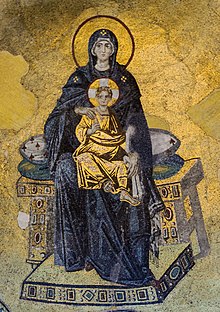| Revision as of 20:57, 14 January 2025 editMaybeItsBecauseImALondoner (talk | contribs)Extended confirmed users16,294 edits Translation of it:Nikopoia | Latest revision as of 21:17, 14 January 2025 edit undoMaybeItsBecauseImALondoner (talk | contribs)Extended confirmed users16,294 editsNo edit summary | ||
| (9 intermediate revisions by the same user not shown) | |||
| Line 1: | Line 1: | ||
| {{More references|date=January 2025}} | {{More references|date=January 2025}} | ||
| ], Istanbul.]] | ], Istanbul.]] | ||
| ''' |
'''Nicopeia''' (sometimes transliterated ''Nikopoia'', ''Nikopea'' or ''Nikopeia''; literally 'bringer of victory') is a title of the ] and a type of ] in ] showing Mary frontally, seated on a throne and holding the Christ Child in her arms.<ref>{{in lang|el}} Konstantinos D. Kalokyris, ''Η Θεοτόκος εις την εικονογραφίαν Ανατολής και Δύσεως'' (''The Theotokos in the Iconography of the East and the West'') Thessaloniki: Patriarchal Institute for Patristic Studies, 1972, p. 66.</ref> A conceptually similar idea in the Western Church is ].<ref>{{Citeweb|url=http://www.liturgiabizantina.it/icone/testi/theotokos_3.htm|title=Enthroned Virgin}}</ref> It is similar to the ''Theotokos Kyriotissa'' (enthroned Madonna) and the Tuscan ']'. | ||
| The title derives from the belief that Mary would defeat Byzantium's enemies. The type was considered as the protector of the state and of the army and was similarly honoured to the ]. It was carried as a banner and hung at the gates of Constantinople.<ref>{{in lang|el}} Kalokyris (1972), pages 66-67</ref> | |||
| Possibly imitating an example in ], the Venetians placed a similar image in ]. A conceptually similar idea in the Western Church is ].<ref>{{Citeweb|url=http://www.liturgiabizantina.it/icone/testi/theotokos_3.htm|title=Enthroned Virgin}}</ref> | |||
| From the 6th century onwards the type appears on Byzantine seals and Byzantine coins, replacing the pagan goddess ] and even adapting the goddess' shield into a medallion or ] bearing an image of Christ granting victory. Later the type appears on coins of ] and ] and later still in frescoes in ], Tutenisa, ] and ].<ref>{{in lang|el}} Kalokyris (1972), page 67</ref> Possibly imitating an example in ], the Venetians placed a similar image in ]. | |||
| ==References== | ==References== | ||
Latest revision as of 21:17, 14 January 2025
| This article needs additional citations for verification. Please help improve this article by adding citations to reliable sources. Unsourced material may be challenged and removed. Find sources: "Nicopeia" – news · newspapers · books · scholar · JSTOR (January 2025) (Learn how and when to remove this message) |

Nicopeia (sometimes transliterated Nikopoia, Nikopea or Nikopeia; literally 'bringer of victory') is a title of the Virgin Mary and a type of icon in Byzantine art showing Mary frontally, seated on a throne and holding the Christ Child in her arms. A conceptually similar idea in the Western Church is Our Lady of Victory. It is similar to the Theotokos Kyriotissa (enthroned Madonna) and the Tuscan 'Maestà'.
The title derives from the belief that Mary would defeat Byzantium's enemies. The type was considered as the protector of the state and of the army and was similarly honoured to the Hodegetria. It was carried as a banner and hung at the gates of Constantinople.
From the 6th century onwards the type appears on Byzantine seals and Byzantine coins, replacing the pagan goddess Nike and even adapting the goddess' shield into a medallion or imago clipeata bearing an image of Christ granting victory. Later the type appears on coins of Michael VII Doukas and Nikephoros Botaneiates and later still in frescoes in Cappadocia, Tutenisa, Serbia and Russia. Possibly imitating an example in Hagia Sofia, the Venetians placed a similar image in St Mark's Basilica.
References
- (in Greek) Konstantinos D. Kalokyris, Η Θεοτόκος εις την εικονογραφίαν Ανατολής και Δύσεως (The Theotokos in the Iconography of the East and the West) Thessaloniki: Patriarchal Institute for Patristic Studies, 1972, p. 66.
- "Enthroned Virgin".
- (in Greek) Kalokyris (1972), pages 66-67
- (in Greek) Kalokyris (1972), page 67
This art-related article is a stub. You can help Misplaced Pages by expanding it. |
This Christianity-related article is a stub. You can help Misplaced Pages by expanding it. |